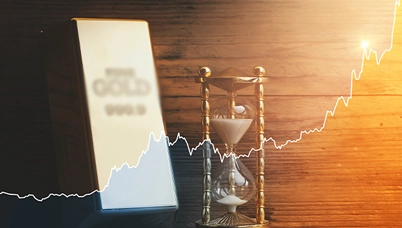Is the 1970s Gold Run back?
Posted On Monday, Mar 05, 2012
We often create stories to make sense of what is going on around us and look at history to find reasoning that provides the substance to base our thesis on. In doing so,we often find historical events, which seem close proximations and follow them as a guide, unless proved wrong by the recent unfolding. And in financial markets,ths process could be really painful.
In gold markets, we`re also comparing the current bull run to that of 1970 s expecting the same result. But there is a cautionary remark - as gold hits set a new peak at $1920/oune- is gold poised for a similar tumble, the way it did in the 80s-tumbled after peaking at $850/ ounce. This has become a thesis and market experts would battle against any view as it threatens their sense of meaning. They tend to ignore the subtle difference that underlies the current movements. They believe that history repeats itself and the recent patterns will mimise its historical past in terms of duration as well as price magnitude.
By the logic, let`s see where we are in the current bull run as compared to that of 70s.

Source: Bloomberg
The 70s bull run began in 1971 when U.S president Rrichard Nixon shut the gold window; ending the direct convertibility of U.S dollar to gold at $35 an ounce.In effect, he took the whole world off the vestiges of the gold standard, which completed a duration of 9 years till gold price peaked in 1980.
The current run, starting in 1999 when prices bottoned totals a dupation of 12 years, Surpassing the earlier bull run. Does this make irrelevant? No! Looking at price history, however, it seems the rally started in 1971.
The bull market probably began before than that-perhaps even before 1961-when buying pressure was suchthat the London Gold pool was introduced to stabilise the gold prices. However ther were no visible gain as the official gold price remained at $35 an ounce,even with the on going dollar printing. So from a duration perspective,ther is no logical comparison.

Let`s get the price magnitude in the picture. Gold began at $35 an ounce in 1970`s. By the time it reached $ 850 level, it had gone up almost 25 times. Gold began the current bull market at $250 an ounce. A 25-fold increase will give us a target of $6250. It suggests a three - fold increase, from the high set in 2011. Then how do people suggest that gold has peaked based on historical comparisons?
No one can predict prices based on such parameters because the markets, economies and policy making at the broad level are very different during both the periods to even attempt such baseless comparisons, studying what has hppened in the past does not tell what will happen in future, but it helps set our expectations as to what is possible and reasonable. It also prevents us from being surprised when markets dont do the obvious. It is better to learn from the past, and one should not overlook, while appreciating the similarities, the subtle differences among the different time periods.
There are numerous similarities as for wider economy, between now and the 70s: a bull market in comodities, inflation, high unemployment, economic and social problems, floundering government and policy makers, volatility across asset markets and so on.
In the 70s, for instance, there was big spending on account of the Vietnam War and President Lyncon Johnson`s Great Society`s social programmes.
Deficits were large and inflation, oil and gold were soaring whereas the dollar was sliding down. Today, there is even bigger spending as the war on terror continues. Deficits are huge, oil and gold have been soaring, inflation is picking up, and the dollar is declining.
But there are many differences too. The most significant is that the post-Bretton Woods monetory system was in its infancy. Whereas, the fiat monetary system is well eastablished today.
In the 70s, the economy was in a better shape than today. At the end of the 70s (nearing the end of the bull market in gold), the employment picture was quite healthy. But now, we have a massive problem with unemployment along with wildly out-of-control debt on both the private and public levels. Thus, Paul Vockler`s simplistic solution to inflation which also served as the trigger for the end of the 1970s gold bull market of increasing interest rates, is off the table.

There is unprecedented inflation that has been defined as an increase in the monetary base. What`s missing, so far, is the inevitable consequence of the inflation - steady rising prices. Inflation will appear and when it does, the government will find it difficult to put the inflation genie back in the bottle, as increasing interest rates would not be desirable with such high levels of debt.

The action to dramatically raise interest rates during the 1970 era indicated that the Fed was willing to take an eco-nomically destructive move to support the Dollar`s value. However, at present, actions have been more accommoda-tive and liquidity infusions are sustained with a policy to mask the problems faced. The debt burden today is so huge that rising interest rates would make servicing the debt incredibly difficult.
The past doesn`t tell us what will happen in the future, but it does help us set our expectations with regard to what is both possible and reasonable. It should also prevent us from being surprised when markets don`t perform the way they should.
The interesting difference with the gold bull market of today and that of the 1970`s is that today the rest of the world is getting involved due to the global economic crisis and fear of fiat paper. As evident from World gold council`s, gold demand trend reports, China and India are buying gold in hundreds of tons over the last few years. It is estimated that only about 10% of the world could own gold during the 70s bull run. This was due to either legal restrictions or a lack of liquid capital, 90% of the world populace was unable to join the gold buying league. Today, few countries prohibit gold ownership, and a far higher percentage of the world`s population has transitioned out of poverty. Still, the fact remains, today less than 1% of assets internationally are allocated to gold investments is another bullish contrarian indicator. That is in stark comparison to the end of the last bull market in 1980 when 26% of global investments were allocated to gold.
Another difference this time around is that no country wants a strong currency, in order to compete in the global marketplace. The end result is that gold is now rising around the world, hitting records and attracting attention, reinforcing that investors worldwide are putting more faith in gold.
These differences suggest the current gold rise could be even bigger than the bull market of the 1970s, and they provide even more fuel for today`s gold bull market. The recent recoil in its prices should be viewed as a buying opportunity rather than the beginning of its downtrend.
The views expressed in this article are the personal views of the Fund Manager of Quantum Gold Fund. The views constitute only the opinions and do not constitute any guidelines or recommendation on any course of action to be followed by the reader. This information is meant for general reading purpose only and is not meant to serve as a professional guide/investment advice for the readers. This article has been prepared on the basis of publicly available information, internally developed data and other sources believed to be reliable. Readers are advised to seek independent professional advice and arrive at an informed investment decision before making any investments.
Statutory Details and Risk Factors:
Mutual Fund investments are subject to market risks, read all scheme related documents carefully.
Risk Factors: All Mutual Funds and securities investments are subject to market risks and there can be no assurance that the scheme`s objective will be achieved and the NAV of the scheme(s) may go up or down depending upon the factors and forces affecting securities markets. Investors in the Scheme(s) are not being offered a guaranteed or assured rate of return. Investment in mutual fund units involves investment risks such as trading volumes, settlement risk, liquidity risk, default risk including possible loss of capital. Past performance of the Sponsor / AMC/ Mutual Fund does not indicate the future performance of the Scheme(s). Statutory Details: Quantum Mutual Fund (the Fund) has been constituted as a Trust under the Indian Trusts Act, 1882. Sponsor: Quantum Advisors Private Limited. (liability of Sponsor limited to Rs. 1,00,000/-) Trustee: Quantum Trustee Company Private Limited. Investment Manager: Quantum Asset Management Company Private Limited (AMC). The Sponsor, Trustee and Investment Manager are incorporated under the Companies Act, 1956.
Related Posts
-

Equity Monthly for January 2026
Posted On Friday, Jan 02, 2026
Indian markets remained range-bound in 2025
Read More -

Gold Monthly for January 2026
Posted On Thursday, Jan 01, 2026
Gold Market Review and Outlook: 2025–2026
Read More -

Debt Monthly for January 2026
Posted On Thursday, Jan 01, 2026
Navigating 2026: India’s Bond Market in a Changing Global Landscape
Read More



